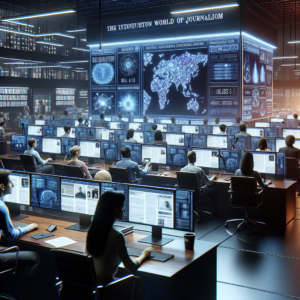Would an Artificial-Intelligence Bubble Be So Bad?
Artificial intelligence (AI) has rapidly emerged as a transformative technology, captivating the attention of industries, governments, and the general public alike. With its potential to revolutionize everything from healthcare to finance, AI is undeniably at the forefront of innovation. However, as investments pour into the sector and valuations skyrocket, some experts are raising concerns about the possibility of an artificial-intelligence bubble. But would such a bubble be as detrimental as past economic downturns, or could it pave the way for a more profound and sustainable advancement in technology?
The Rise of AI: Past and Present
To understand the implications of a potential AI bubble, it’s essential to take a look at the historical context of technology bubbles. The dot-com bubble of the late 1990s serves as a cautionary tale. During that period, investments in internet-based companies reached astronomical levels, leading to a market crash when valuations proved unsustainable. Yet, despite significant losses, the underlying technology—the internet—survived and flourished, ultimately reshaping how we communicate, work, and live.
Today, AI stands at a similar crossroads. The technology has made enormous strides in recent years, leading to breakthroughs in natural language processing, computer vision, and machine learning. As companies leverage AI for predictive analytics, automation, and personalized customer experiences, the demand for AI solutions is skyrocketing.
Current Investment Trends
Investment in AI technology has surged, with venture capitalists and corporations alike pouring billions into startups and established firms. According to a report by Statista, global investment in AI reached over $66 billion in 2021, a figure that is expected to grow as more industries adopt AI solutions. This influx of capital has led to inflated valuations, with some AI startups being worth billions despite minimal revenue.
Such rapid growth raises questions about sustainability. Are we witnessing a genuine technological revolution, or are we simply riding the wave of hype?
The Hype Cycle: Navigating AI’s Future
The concept of the “hype cycle,” developed by Gartner, provides a framework for understanding how emerging technologies gain traction. This cycle usually includes five phases:
1. Innovation Trigger
2. Peak of Inflated Expectations
3. Trough of Disillusionment
4. Slope of Enlightenment
5. Plateau of Productivity
Currently, AI seems to be oscillating between the second and third phases of this cycle. With companies showcasing impressive AI capabilities, expectations are soaring. Yet, some are beginning to feel the weight of unrealistic promises that AI can solve all problems.
Are We Heading Towards a Bubble?
Critical voices in the tech industry question whether the current excitement surrounding AI is sustainable. Some analysts argue that while AI technologies have vast potential, the current market dynamics suggest we may be nearing a bubble. The overvaluation of AI firms could lead to a significant correction if these companies fail to deliver on their lofty promises.
However, it’s essential to consider the nature of the technology itself. Unlike past bubbles, the underlying principles of AI—machine learning, data analytics, and cognitive computing—are fundamentally transforming industries, not simply creating temporary fads.
The Potential Upside of an AI Bubble
But what if there is a bubble? Would it be as catastrophic as previous market crashes? Some experts argue that an AI bubble could have a positive outcome, even if it bursts.
Innovation Through Failure
History has shown that market corrections can lead to greater innovation. When companies overreach and fail to fulfill expectations, it forces the industry to recalibrate. This failure can prompt more sustainable business models, encourage rigorous validation of AI technologies, and lead to advancements that are more aligned with actual market needs.
Furthermore, a bubble may act as a catalyst for investment in foundational AI research. As companies look to solidify their positions in a potentially contracting market, funding could shift toward developing robust and scalable AI technologies that provide genuine value.
Long-Term Prospects for AI
While the prospect of an AI bubble may be concerning, it’s crucial to maintain a long-term perspective. Most transformations in technology are not linear; they come with their ups and downs.
AI’s Role in Society
The more pressing question is not whether an AI bubble will happen, but rather how AI can be integrated responsibly into society. As AI continues to permeate various sectors, ethical considerations must remain at the forefront. Issues surrounding data privacy, algorithmic bias, and job displacement need to be addressed proactively to ensure that AI benefits everyone.
Moreover, a potential bubble could lead to greater regulatory scrutiny, fostering an environment where ethical standards around AI development are established. This could help mitigate any potential risks while also ensuring that the technology is harnessed for the greater good.
Conclusion: Embracing the Journey
Ultimately, whether an artificial-intelligence bubble is on the horizon remains uncertain. While the market dynamics may suggest an unsustainable trajectory, it’s essential to recognize the fundamental advancements that AI is making in various industries.
If a bubble does form and subsequently burst, it may lead to a more conservative and responsible approach to AI development. This could foster genuine innovation that benefits society as a whole.
As we navigate through the complexities of AI, embracing both the potential and the pitfalls will be crucial. After all, the journey of innovation is rarely straightforward; it is often marked by both triumphs and challenges. Recognizing this can help us prepare for the future of AI and ensure that it ultimately serves as a force for good in our world.



